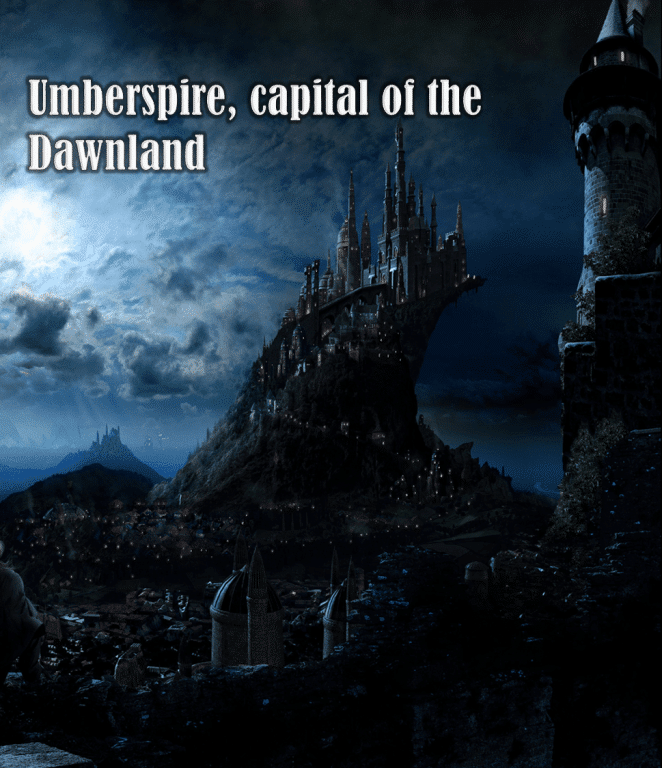Umberspire is the new center of civilization in the Dawnlands, after the unbelievable devastation wrecked by the Godbeast Nehnaxiir many decades ago.
Reputation of the City
Today the city is the undisputed center of civilization in the Dawnland, and a neutral point between the conflicts of the deities of the Realms. The opening of the Dawnland to the rest of the Realms was an opportunity that Umberspire seized with enthusiasm, establishing a ruthless commercial culture with trade links to many neighbours and other Realms, often by coercion.
The mage-council of Umberspire craves power and knowledge, and its members come from every tradition of magic of the realms: from the dark magicks of the Chaos Gods to the celestial power of the Seraphon, from the blood rituals of Khainites to the mad curses of the Bad Moon.
The city has attracted a number of mystics and scholars, as well as ambitious treasure-seekers and spies, due to the prophetic visions granted by the city’s geological properties. A veritable trade in knowledge, often dangerous and valuable secrets, has grown from it. This reputation has become the talk of dark rooms of libraries and coffee houses the Realms over.
The Spire itself
The gigantic spire is a hollowed splintered shard, rising from the edge of the abyss where Nehnaxiir had crashed into the ancient canal city Sy’dell. This arcane and dark place is run by a cabal of mages and assassins who enforce laws with brutal efficiency, and brook no argument from their citizens. The weak may perish, but the strong reap rewards that only law and magic can provide. Individuals from every walk of faith and belief, from orruks to blood warriors, to savage Seraphon, gheists or mortal humans, they pitch their chances and fortune in rising through the ranks of Umberspire society.
The Mouth District
Water from the sea drains into the bottomless pit surrounding the base of the spire, which provides a reliable source of power for watermills. An expansive shanty town has spread for decades now, all under the safe shadow cast by the Umberspire, after the warlords of the Confederation of Nine were left scattered and their rulership over the wastes of the Dawnland broken.
But there is more than just water mills and slums in the sprawling citystate around the Umberspire itself. Those that stand at the rim of the hole claim mystic vapors inspire visions and even true powers of future sight. The “Mouth District” is a collection of platforms, temples, and monestaries built on the inside rim of the hole where anyone can pay coin to have their fortunes told. The value of prophecies in the city runs from the very cheap weather forecast, to very expensive portents of doom and murder that are highly prized by both political actors as well as scholars.
The Prophecy Trade
The booming market for prophecies has led the city to become somewhat a rival for Excelsis’ trade, with prophecies being sold and bought, and their potential value appraised by so-called experts. Though unlike Excelsis, in Umberspire there is little in the way of its government attemtpting to contain dangerous knowledge granted by the visions. This has caused common citizens to adopt future forescasting as an everyday part of life, leading often to dangerous obssessions about controlling their own fate. Many Umberspirians are paranoid and mad due to this, but such behaviour is considered commonplace in the city. And for those ambitious enough, entire careers rely on using prophetic information cleverly so as to outsmart their rivals who also possess similar information. A very complicated game of cat and mouse occurs among the movers and shakers of the city, where everyone is trying to amass more information and play a very complicated chess game against each other.
The city Council promotes the prophecy business, regardless of its social repercusssions, as it aids the speculative worth of each scrap of information and increases their revenues for the tax they collect on each sale, as information can be sold and re-sold (though its authenticity may be put into question). It also cements the city’s reputation in the Realms as information brokers, attracting interested parties from all over. It goes without saying, that whenever a particular portentous prophecy hits the market, city officials and powerful wealthy interests move to muscle in on it, and depending on how critical it is, the Council members themselves may confiscate it for its own gain (often feuding with each other for it).
Complex financial contracts have been develped to take advantage of the surge in potentially valuable information: individuals holding a prophecy may not necessarily have the means to exploit it for its value, and see it through to its end. Sometimes one must be in the right place at the right time for it to come true, or it may come to pass and its value will only be there for the taking if you are standing in the right location or talked to the right people. So it has become custom for lending contracts to allow third parties privy to the prophecy, with a promise of returning a percentage of the fulfilled value of the prophecy bakc to the lender. This could be a prophecy that leads to riches, a powerful arcane secret, or politically useful information on a rival (that may benefit all the parties involved to know). Many known exploits, important finds and historical sabotages, throughout the Realm’s recent history, were in fact guided by prophecies loaned from Umberspire’s sellers.
These “futures contracts” are complex and hard to understand especially for outsiders, but that doesn’t stop attempts to try and break them, by fleeing or simply refusing to deliver their pay, believing themselves forgotten by Umberspire thanks to distance and time. The city does not forget, and usually sends the Hounds of the Inquisition are often sent abroad to exact repayment of these debts by force, even after centuries of the initial prophecy sale.
The Library of Souls
After the godbeast Nehnaxiir left the Dawnland, a cabal of scholars quickly tapped into the powers of the Crystal fragments. Many larger crystals hold divination powers, or carry echoes of the Godbeast’s endless store of knowledge. Thus a Library was started.
The smallest fragments were also steadily collected, slowly and out of sight, in an inspiration from Nagash’s own grand plan of collecting gravesand. Small fragments have little power, but can still be used to hold a mortal’s soul and knowledge indefinitely, analogous to what was achieved with shadeglass by the Katophranes of Shadespire. Captive souls can be used to hold information, and can even be manipulated via shadow magic to perform mental tasks and research for the Keepers of the Library. Some are held in full possession of their faculties within large crystals, others are specially reanimated into liches and their skin and viscera used to make crystal-encrusted talking books, while others are kept only as disembodied heads, holding debates and endless arguments. It is immortality, of a sort.
Thus these Soul Keepers raised, over the years, the Soul Library. Hidden behind layers of shadow illusions, it houses valuable knowledge from the time before the Godbeast, and from elsewhere in the realms. As an enterprise, it serves both as a broker of secret knowledge as well as a research institute. Some mortal scholars at the end of their lives have willingly volunteered to have their souls captive, in exchange to being allowed to pursue their research. Others donate their souls as workhorse “rememberers”, in exchange for financial support for their families.
Otherwise, the Library is known to use often brutal methods to acquire some souls whose knowledge it considers essential to preserve, or cannot allow to fall into the wrong hands: this role falls to the Temple-Knights of the Inquisition. And its coffers are never empty, as there are always those in search of hidden and ancient knowledge, or answers to complex problems, and know the Library can provide it. Therefore, many even in the wider Realms wish it remains protected and untouched, even if they disagree with their methods.




